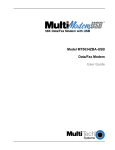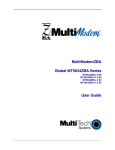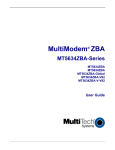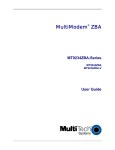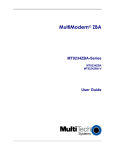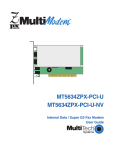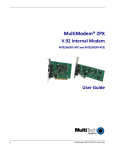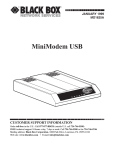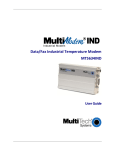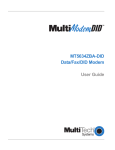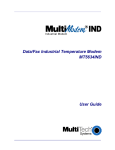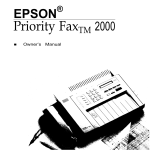Download Multitech MT5634ZBA-USB User guide
Transcript
MultiModem® USB 56k Data/Fax Modem with USB MT5634ZBA-USB Data/Fax Modem User Guide User Guide MultiModemUSB (MT5634ZBA-USB) S000247F Revision F All rights reserved. This publication may not be reproduced, in whole or in part, without prior expressed written permission from Multi-Tech Systems, Inc. Copyright © 2009 by Multi-Tech Systems, Inc. Multi-Tech Systems, Inc. makes no representations or warranties with respect to the contents hereof and specifically disclaims any implied warranties of merchantability or fitness for any particular purpose. Furthermore, Multi-Tech Systems, Inc. reserves the right to revise this publication and to make changes in the content hereof without obligation of Multi-Tech Systems, Inc. to notify any person or organization of such revisions or changes. Check Multi-Tech’s web site for current versions of our product documentation. Record of Revisions Revision Date C 11/17/04 D 05/22/06 E 05/11/07 F 12/27/07 06/08/09 Description Manual revised to correct file name for Windows 2000 driver. Manual revised to include WEEE Statement. Revised logo & tech support listing and revised passages for copyright, trademarks, & warranty/repair. Revised Tech support contact listing. Add link to the Multi-Tech Web site for warranty information. Trademarks MultiModem, Multi-Tech, and the Multi-Tech logo are registered trademarks of Multi-Tech Systems, Inc. Microsoft, Windows, Windows 98, Windows Me, Windows NT, Windows 2000, and Windows XP are either registered trademarks or trademarks of Microsoft Corporation in the United States and/or other countries. Any other brand and product names mentioned in this publication are trademarks or registered trademarks of their respective companies. Warranty For the Multi-Tech Warranty, see the Multi-Tech Web site at http://www.multitech.com/COMPANY/Policies/warranty/ Patents This device is covered by one or more of the following patents: 6,031,867; 6,012,113; 6,009,082; 5,905,794; 5,864,560; 5,815,567; 5,815,503; 5,812,534; 5,809,068; 5,790,532; 5,764,628; 5,764,627; 5,754,589; D394,250; 5,724,356; 5,673,268; 5,673,257; 5,644,594; 5,628,030; 5,619,508; 5,617,423; 5,600,649; 5,592,586; 5,577,041; 5,574,725; D374,222; 5,559,793; 5,546,448; 5,546,395; 5,535,204; 5,500,859; 5,471,470; 5,463,616; 5,453,986; 5,452,289; 5,450,425; D361,764; D355,658; D355,653; D353,598; D353,144; 5,355,365; 5,309,562; 5,301,274. Other patents pending. World Headquarters: Multi-Tech Systems, Inc. 2205 Woodale Drive Mounds View, MN 55112 U.S.A (763) 785-3500 or (800) 328-9717; US Fax (763) 785-9874 Technical Support Contacts Country By Email Europe, Middle East, Africa: [email protected] U.S., Canada, all others: [email protected] Internet Address http://www.multitech.com By Phone +(44) 118 959 7774 800-972-2439 or 763-717-5863 MultiModemUSB User Guide Contents Table of Contents Chapter 1 -- Introduction and Description .................................................................. 4 Product Description .............................................................................................. 4 Universal Serial Bus (USB) .................................................................................. 4 We Supply ............................................................................................................ 5 You Supply ........................................................................................................... 5 Safety Warning Telecom ...................................................................................... 5 Chapter 2 – Installation ................................................................................................. 6 Step 1: Assemble the Modem .............................................................................. 6 Step 2: Connect the Modem to Your PC .............................................................. 6 Step 3: Install the Modem Driver .......................................................................... 7 Step 4: Country Configuration with Global Wizard ............................................. 10 Chapter 3 - Operation ................................................................................................ 11 Front Panel ......................................................................................................... 11 PhoneTools Features ......................................................................................... 12 V.92 Operation ................................................................................................... 12 Connecting to the Internet .................................................................................. 13 Dial-Up Networking ............................................................................................. 13 Sending a Fax .................................................................................................... 13 Chapter 4- AT Commands, S -Registers, and Result Codes ................................... 14 Chapter 5 - Remote Configuration ............................................................................. 15 Basic Procedure ................................................................................................. 15 Setup .................................................................................................................. 15 Chapter 6- Troubleshooting ....................................................................................... 17 Appendix A - Regulatory Compliance ....................................................................... 20 FCC Part 68 Telecom ......................................................................................... 20 FCC Part 15........................................................................................................ 21 Fax Branding Statement ..................................................................................... 21 Canadian Limitations Notice ............................................................................... 21 Industry Canada ................................................................................................. 22 International Modem Restrictions ....................................................................... 22 EMC, Safety, and R&TTE Directive .................................................................... 22 South African Notice ........................................................................................... 22 Appendix B - Technical Specifications ..................................................................... 23 Appendix C – Waste Electrical and Electronic ......................................................... 24 Appendix D – C-ROHS HT/TS Substance Concentration ........................................ 25 3 MultiModemUSB User Guide Chapter 1 -- Introduction and Description Chapter 1 -- Introduction and Description Welcome to the world of data communications. You have acquired one of the finest intelligent data and fax modems available today from one of America’s oldest and most respected modem manufacturers: Multi-Tech Systems, Inc. This User Guide will help you install, configure, test, and use your modem. It applies whether you are using the V.90 protocol or the V.92 protocol. Product Description Features include: • Plug-and-Play capable. • Interactive automatic dialing and command mode configuration. • In standard mode, you can store up to four command lines or telephone numbers of up to 40 characters each in the modem’s nonvolatile memory. • Pulse- or tone-dials and recognizes dial tones and busy signals for reliable call-progress detection. • Detects AT&T calling card tones. • Caller ID. • Remote configuration. • Incorporates self-resetting lightning protection. Universal Serial Bus (USB) Universal Serial Bus (USB), defined by a consortium of industry leaders, permits connection of multiple low-speed and medium speed computer peripheral devices such as telephones, modems, printers, keyboards, mice, and scanners; all from a single personal computer port. The specification, based on an open architecture is quickly becoming a standard feature in new desktop and notebook computers. 4 MultiModemUSB User Guide Chapter 1 -- Introduction and Description We Supply The MultiModemUSB package contains: √ √ √ √ √ √ An MT5634ZBA-USB data/fax/voice modem A set of four self-adhesive plastic feet A printed Quick Start Guide A MultiModemUSB installation CD containing modem drivers, this User Guide, data communications program (Phone Tools), and other programs One USB cable One modular telephone cable You Supply √ √ A computer with an available USB port A nearby telephone line jack Safety Warning Telecom 1. Use this product only with UL and cUL listed computers. 2. To reduce the risk of fire, use only 26 AWG (.41mm) or larger telephone wiring. 3. Never install telephone wiring during a lightning storm. 4. Never install a telephone jack in wet locations unless the jack is specifically designed for wet locations. 5. Never touch uninsulated telephone wires or terminals unless the telephone line has been disconnected at the network interface. 6. Use caution when installing or modifying telephone lines. 7. Avoid using a telephone during an electrical storm. There is a risk of electrical shock from lightning. 8. Do not use a telephone in the vicinity of a gas leak. 9. This product must be disconnected from its power source and telephone network interface when servicing. 5 Chapter 2 - Installation MultiModemUSB User Guide Chapter 2 – Installation Step 1: Assemble the Modem The only assembly required is to mount the feet on the bottom of the modem. Simply peel the four selfadhesive plastic feet off the backing strip and press them into the recesses on the bottom of the modem. Step 2: Connect the Modem to Your PC Placing the modem in a convenient location, connect it to your computer’s USB port, to the telephone line, and, optionally, to your telephone. USB PHONE LINE USB Connection Plug one end of the USB cable into the USB connector on the modem, and the other end into a USB port connector on your computer. Line Connection Plug one end of the phone cable into the modem’s LINE jack and the other end into a phone line wall jack. Note: The LINE jack is not interchangeable with the PHONE jack. Do not plug the phone into the LINE jack or the line cable into the PHONE jack. Note: The Federal Communications Commission (FCC), and Industry Canada impose certain restrictions on equipment connected to public telephone systems. See Appendix A for more information. Phone Connection For voice-only calls, you can optionally plug a telephone into the modem’s PHONE jack. 6 MultiModemUSB User Guide Chapter 2 - Installation Step 3: Install the Modem Driver The MT5634ZBA-USB drivers need to be installed in your computer’s program directory. The procedure will be different depending on the operating system. This section provides installation procedures for Windows XP, 2000, ME, and 98. Installation in Windows XP/2003 1. Power up your Windows XP system. 2. If you have not already done so, make all the necessary connections, including connecting the modem to an available USB port. 3. Insert the MultiModem USB CD into your CD drive. 4. Windows will detect that the new modem is present and launch the Update Device Driver Wizard dialog box. 5. Choose Install from a list or specific location (Advanced), and click Next. 6. Select Don’t Search. I will choose the driver to install, and click Next. 7. Click the Have disk button. Browse to x:\Drivers\Windows XP. Select the file there and click OK. (x denotes the drive letter of your CD drive). 8. When the pop-up window comes up explaining that the driver is not digitally signed, click Continue anyway to finish the installation. NOTE: This Microsoft operating system searches for a digital signature when you install any new hardware. If a "Digital Signature Not Found" screen appears, simply click the YES button to continue installation. Although Multi-Tech submits all eligible products to Microsoft for certification, the turn-around time is subject to many factors. Not having a digital signature does not affect product performance in any way. Installation in Windows 2000 1. Power up your Windows 2000 system. 2. If you have not already done so, make all the necessary connections. 3. Windows will detect that the new modem is present, indicate that it's in the process of installing, and then launch the Found New Hardware Wizard. The Welcome screen appears first. Click Next. 4. The Install Hardware Device Drivers screen appears indicating that the wizard will install the hardware device drivers. Verify that the Search for a suitable driver for my device (recommended) is selected, and then click Next. 5. The Locate Driver Files screen appears asking where you want Windows to search for driver files. Verify that the Specify a location option is the only one selected, place the MultiModemUSB CD into your CD drive, and click Next . 6. The next screen will say Insert the manufacturer’s installation disk into the drive selected and then click OK. Click the Browse button (when prompted to insert a disk into drive A:\, click Cancel). Navigate to x:\Drivers\Windows 2000. Select the file and click OK. (x denotes the drive letter of your CD drive). 7. Then the Driver Files Search Results screen appears indicating that Windows has found the proper driver on the CD. Click Next to install the selected driver. 8. The Digital Signature Not Found dialog box is displayed. Click Yes to continue with the installation. See the digital signature note above. 7 MultiModemUSB User Guide Chapter 2 - Installation 9. A Copying Files screen appears briefly. After the files have been copied to your PC, a Found New Hardware Wizard screen appears indicating that Windows has finished installing the driver. Click Finish to complete the installation and exit the wizard. After installation is complete, you should test the operation of your new MultiModemUSB by registering it. Key in the URL given below and follow the online instructions at: http://www.multitech.com/register Installation in Windows ME The MultiModemUSB driver files for Windows ME are installed in two groups, as described below. The installation wizard begins by installing certain driver files. At that point, Windows ME detects the modem as a new device. Then the installation wizard runs again to install the remaining driver files. 1. Power up your Windows ME computer. 2. If you have not already done so, make all the necessary connections. 3. Place the MultiModemUSB CD into the CD drive of your PC. Windows ME will detect that the new modem is present and launch the Add New Hardware Wizard screen. This message then displays: “What would you like to do?” Choose Specify the location of the driver (Advanced) and click Next. 4. At the Add New Hardware Wizard “Windows will search for new drivers ...” screen, uncheck the “Removable Media” button (if necessary) and check “Specify a location.” 5. Click the “Browse” button and navigate to the “Windows ME” subfolder of the “Drivers” folder on the MultiModemUSB CD. Click OK. Click Cancel if it prompts you for a floppy disk. 6. The Add New Hardware Wizard “Windows driver file search ...” screen appears. Click Next. 7. Transient progress screens will appear while files are being copied. After the files have been copied to your PC, an Add New Hardware Wizard screen will appear indicating that Windows has finished installing this the first of two drivers. Click Finish to complete the installation of this first driver. The wizard will close. 8. Windows ME will now detect an “Unknown Device” and begin another Add New Hardware Wizard, again asking “What would you like to do?” Choose “Specify the location of the driver (Advanced)” and click Next>. 9. At the next screen, (the Add New Hardware Wizard “Windows will search for new drivers...” screen), uncheck the “Removable Media” button (if necessary) and check “Specify a location.” Click Next. 10. Transient screens will appear while files are being copied. The Add New Hardware Wizard “Windows driver file search...” screen will appear. Click Next. 11. After files have been copied, a completion screen will appear. Click Finish to complete the installation of this the second driver. The wizard will close. 12. Remove the MultiModemUSB CD from the computer’s CD drive. 13. Test the operation of your modem by registering it online at http://www.multitech.com/register. 8 MultiModemUSB User Guide Chapter 2 - Installation Installation in Windows 98 1. Power up your Windows 98 system. 2. If you have not already done so, make all the necessary connections. 3. Insert the MultiModem USB CD into your CD drive. 4. Windows will detect that the new modem is present and launch the Add New Hardware Wizard. The first screen indicates that the wizard will search for a USB driver. 6. The message What do you want Windows to do? displays. Verify that the Search for the best driver for your device (Recommended) option is selected and click Next. 6. The message Windows will search for a new driver.. displays. Verify that the CD-ROM drives option is selected and click Next. 7. The Add New Hardware Wizard dialog box indicates that Windows has found an updated driver for this device. Verify that the Updated driver (Recommended) option is selected and click Next. 8. The Wizard dialog indicates that Windows will select the proper driver from the MultiModemUSB CD and verify the information. Click Next to install the selected driver. 9. After the files have been copied to your PC, the Wizard screen appears indicating that Windows has finished installing the driver. Click Finish to complete the installation and exit the wizard. The TR LED on your modem will light when the installation is complete. Remove the CD from the computer. After installation has been completed, you should test the operation of your new MultiModemUSB by registering it. Key in the URL given below and follow the online instructions: http://www.multitech.com/register 9 Chapter 2 - Installation MultiModemUSB User Guide Step 4: Country Configuration with Global Wizard Different countries have different requirements for how modems must function. Therefore, before you use your modem, you must configure it to match the defaults of the country in which you are using it. You can use one of two configuration methods: D Using the Global Wizard to Configure Your Modem D Using AT Commands to Configure Your Modem Using the Global Wizard to Configure Your Modem The Global Wizard configuration utility is recommended for computers running Windows 98/Me/2000/XP. 1. Insert the MultiModemUSB CD into the CD-ROM drive. The Autorun dialog box appears. 2. Click Initial Setup and Country Selection. 3. Choose either: - Run Global Wizard from CD. This will not load the wizard onto your hard drive, or - Install Global Wizard on the HD. This will install the wizard onto your hard drive for future use. 4. The Global Wizard dialog box appears. Click Next. 5. The Global Wizard searches for your modem and identifies it. Click Next. 6. Select the country in which the modem will be used, and then click Next. 7. Review your choice of country. If it is correct, click Next to configure the modem. 8. When Global Wizard announces that the parameters have been set, click Finish to exit. Using AT Commands to Configure Your Modem Non-Windows users can configure the modem using AT commands. You must enter these commands in your communication program’s terminal window. 1. Run your favorite communication program or use Phone Tools (on the CD that is packaged with your modem) and open the program’s terminal window. 2. To configure the modem for a specific country, type AT%T19,0,nn, where nn is the country code in hexadecimal format, and then press ENTER. The message OK displays. 3. To verify the change, type ATI9, and then press ENTER. The country/region code displays: Example Country/Region AT command (hexadecimal) Country code (decimal) Euro/NAM 52 AT%T19,0,34 (default) The complete list of country/region codes can be found on the Multi-Tech Web site at http://www.multitech.com/PRODUCTS/Categories/Modems/global/configuration.asp#chart 10 Chapter 3 - Operation MultiModemUSB User Guide Chapter 3 - Operation Front Panel Figure 3-1. Front panel The MT5634ZBA-USB has 6 LED indicators on the front panel that indicate status, configuration, and activity: TD Transmit Data. The TD LED flashes when the modem is transmitting data to another modem. RD Receive Data. The RD LED flashes when the modem is receiving data from another modem. CD Carrier Detect. The CD LED lights when the modem detects a valid carrier signal from another modem. It is on when the modem is communicating with the other modem and off when the link is broken. OH Off-Hook. The OH LED lights when the modem is off-hook, which occurs when the modem is dialing, online, or answering a call. The LED flashes when the modem pulse-dials. TD Terminal Ready. The TR LED lights when Windows detects and initializes the modem. Power. The PWR led lights when the system is applying power to the modem. 11 MultiModemUSB User Guide Chapter 3 - Operation PhoneTools Features Using the PhoneTools communications program included with your modem, you can: • Upload and download data files. • Send faxes at preset times. • Store incoming voice messages and faxes. • Retrieve stored messages, faxes, and telephone numbers (telephone number retrieval requires Caller ID service from your telephone company). • Print a received fax. For detailed information about operating your modem under PhoneTools, please refer to the PhoneTools documentation included on the MT5634ZBA-USB CD. V.92 Operation Because the V.92 protocol is new and still largely unsupported by central servers, some features are disabled by default in the initial release of the MT5634ZBA-USB modem. This section describes the status of the V.92 features in the initial release. Please note that the V.92 special features require connection to a V.92-capable server. • General. The V.92 protocol is enabled by default. If the MultiModemZBA-USB detects another V.92 modem during the handshake phase, they will connect in V.92 mode; otherwise, they will connect in V.90 mode or the highest mutually acceptable mode. The AT command that controls this is +MS=. • Commands. AT commands specific to the V.92 protocol and the new V.44 compression protocol begin with the plus character (+). These commands are in this manual. • PCM Upstream. PCM Upstream is disabled by default. To upload files at speeds above 33.6 kbps, you must enable PCM Upstream using the command +PIG=1. Please note that this requires connection to a V.92-capable server. Also, please note that since upload speeds are affected by line conditions, meeting the previous requirements cannot guarantee speeds above 33.6 kbps. • Quick Connect. Quick Connect, which shortens the handshake time with another V.92 modem, is disabled by default. To enable it, use the command +PQC=0. Quick Connect speeds connect times by skipping the line test during the handshake and using the configuration from the last data connection. Quick Connect works best when line conditions are consistent from call to call. If line conditions are variable, enabling Quick Connect can actually increase the connect time slightly. 12 MultiModemUSB User Guide Chapter 3 - Operation Connecting to the Internet Your Multi-Tech modem is your gateway to the Internet and the World Wide Web. To access the Internet and Web via your modem, you must establish a dial-up account with an Internet service provider (ISP). To locate an ISP near you, look in a local directory or computer publication. Your ISP should provide you with the following information: • User name (also called user ID) • Password • Access number (the number you call to connect to the server) • Host name and/or domain name • Domain Name Server (DNS) server address If, besides the Web, you use the Internet for e-mail and newsgroups, your ISP should also provide you with the following information: • E-mail or POP mail address • POP server address • Mail or SMTP address • News or NNT server address Dial-Up Networking Before you can connect to the Internet, you must set up a remote-node client program on your computer. The Windows version is called Dial-Up Networking. Dial-Up Networking establishes your connection to the ISP’s server, which is the shared computer that manages calls from clients (your computer) to the Internet. Most, if not all, Windows browsers start Dial-Up Networking automatically when you open them. For instructions on how to set up Dial-Up Networking, consult your ISP or your operating system’s online help or printed documentation. Many ISPs include with their service a program that will install and configure Dial-Up Networking automatically for you. Sending a Fax You can use the PhoneTools program included with your modem to send and receive faxes directly from your computer. The following procedure uses print capture, which enables you to fax a document directly from the Windows application in which you created it without opening PhoneTools. 1. Install PhoneTools if it is not already installed. 2. Create a document in a Windows application, such as a word processor, graphic editor, or spreadsheet. To fax the document, keep the document open and select the Print command from the File menu. 3. Select CAPTURE FAX +BVRP as the printer driver, and then click OK. The Send Fax wizard appears. 4. In the Recipient section, type the required information or extract it from the Phone Book by clicking . 5. In the Template section, optionally select a cover page and type a cover message. 6. Select the document to be sent. The default file when sending from within a Windows application is Capture.dgr. 7. Select the date and time to send the document, if you do not want to send it immediately. 8. Click Finish to start the transmission. 13 MultiModemUSB User Guide Chapter 4 - AT Commands, S-Registers, Result Codes Chapter 4- AT Commands, S -Registers, and Result Codes The AT Commands, S-Registers, and Result Codes for the MT5634ZBA-USB Modem is published in a separate Reference Guide. This guide is included on the MT5634ZBA-USB CD. You can open the guide from the CD, or you download the guide to your hard drive. 14 MultiModemUSB User Guide Chapter 5 -- Remote Configuration Chapter 5 - Remote Configuration Remote configuration is a network management tool that allows you to configure modems anywhere in your network from one location. With password-protected remote configuration, you can issue AT commands to a remote MT5634ZBA-USB modem for maintenance or troubleshooting as if you were on site. Basic Procedure The following steps are valid regardless of whether the connection is established by the local or the remote Multi-Tech modem. 1. Establish a data connection with a remote MT5634ZBA-USB modem. 2. Send three remote configuration escape characters followed by AT and the setup password, and press ENTER. Example: %%%ATMTSMODEM. You have four tries to enter the correct password before being disconnected. If the password is correct, the remote modem responds with OK. 3. You can now send AT commands to configure the remote modem. 4. When you have finished configuring the remote modem, save the new configuration by typing AT&W0, and pressing Enter. 5. Type ATO and press Enter to exit remote configuration. You can then break the connection in the normal way. CAUTION: If you hang up while you are in remote configuration mode, it may lock up the remote modem. Setup Multi-Tech modems are shipped with a default setup password (MTSMODEM). Because anyone who has an owner’s manual knows the default setup password, for security you should change the password and possibly also the remote configuration escape character. Changing the Setup Password 1. Open a data communications program such as Phone Tools or HyperTerminal. 2. In the terminal window, type AT#SMTSMODEM (or AT#Sxxxxxxxx if you have replaced the MTSMODEM password with xxxxxxxx) and press ENTER. The modem responds with OK if the setup password is correct, and ERROR if it is wrong. 3. To change the password, type AT#S=xxxxxxxx, where xxxxxxxx stands for the password, and press ENTER. The password can include any keyboard character, and must be one to eight characters long. The modem responds with OK. 4. The new password is saved automatically. You can now either enter more AT commands or exit the data communications program. The next time you remotely configure the modem you must use the new setup password. Note: You can only change the setup password locally; you cannot do it remotely. Also, passwords are case sensitive. The next time you enter the password, it must be in the same case as you set it up. 15 MultiModemUSB User Guide Chapter 5 -- Remote Configuration Changing the Remote Escape Character To increase security, you can change a remote modem’s remote configuration escape character. The remote configuration escape character is stored in register S9. The factory default is 37, which is the ASCII code for the percent character (%). Setting S9 to 0 (zero) disables remote configuration entirely— but if you do this remotely, you won’t be able to change it back remotely! 1. Establish a remote configuration link with the remote modem as described in “Basic Procedure.” 2. Type ATS9=n, where n is the ASCII code for the new remote configuration escape character, then press ENTER. 3. Save the new value by typing AT&W and pressing ENTER. 4. Type ATO<CR> to exit remote configuration. 16 MultiModemUSB User Guide Chapter 6 -- Troubleshooting Chapter 6- Troubleshooting Your modem was thoroughly tested at the factory before it was shipped. If you are unable to make a successful connection, or if you experience data loss or garbled characters during your connection, it is possible that the modem is defective. However, it is more likely that the source of your problem lies elsewhere. The following symptoms are typical of problems you might encounter: • None of the LEDs light when the modem is on. • The modem does not respond to commands. • The modem dials but is unable to make a connection. • The modem disconnects while online. • The modem cannot connect when answering. • Data is being lost. • There are garbage characters on the monitor. • The modem doesn’t work with Caller ID. • Fax and data software can’t run at the same time. If you experience problems, please check the following possibilities before calling Technical Support (see Appendix C). None of the Indicators Light When you turn on the modem, the LED indicators on the front panel should flash briefly as the modem runs a self-test. If the LEDs remain off, the modem is probably not receiving power. • Make sure the modem’s power switch is on, especially if you normally turn the modem on by turning on a power strip. • If the modem is plugged into a power strip, make sure the power strip is plugged in and its power switch is on. • Make sure the power supply is firmly connected to the modem and the power supply’s power cord is firmly connected to both to the power supply and the wall outlet or power strip. • If the power strip is on and the modem switch is on, try moving the power supply to another outlet on the power strip. • Test that the outlet is live by plugging another device, such as a lamp, into it. • The modem or power supply may be defective. If you have another Multi-Tech modem, try swapping modems. If the problem goes away, the first modem or power supply might be defective. Call Technical Support for assistance. CAUTION: Do not under any circumstances replace the power supply with one designed for another product; doing so can damage the modem and void your warranty. The Modem Does Not Respond to Commands • • • • • • Make sure the modem is plugged in and turned on. (See “None of the Indicators Light.”) Make sure you are issuing the modem commands from data communication software, either manually in terminal mode or automatically by configuring the software. (You cannot send commands to the modem from the DOS prompt.) Make sure you are in terminal mode in your data communication program, then type AT and press ENTER. If you get an OK response from your modem, your connections are good and the problem likely is in the connection setup in your communication software. Try resetting your modem by unplugging the USB cable from the modem, and then plugging it back in. Try rebooting the computer. The modem might be defective. If you have anoter Multi-Tech modem, try swapping modems. If the problem goes away, the first modem is possibly defective. Call Tech Support for assistance (Refer to Appendix D) 17 MultiModemUSB User Guide Chapter 6 -- Troubleshooting The Modem Dials But Cannot Connect There can be several reasons the ZBA fails to make a connection. Possibilities include • lack of a physical connection to the telephone line. • a wrong dial tone. • a busy signal. • a wrong number. • no modem at the other end. • a faulty modem, computer, or software at the other end. • incompatibility between modems. You can narrow the list of possibilities by using extended result codes. Extended result codes are enabled by default. If they have been disabled, enter ATV1X4 and press ENTER while in terminal mode, or include V1X4 in the modem’s initialization string. When you dial again, the modem will report the call’s progress. • If the modem reports NO DIALTONE, check that the modem’s telephone line cable is connected to both the modem’s LINE jack (not the PHONE jack) and the telephone wall jack. If the cable looks secure, try replacing it. If that doesn’t work, the problem might be in your building’s telephone installation. To test the building installation, plug a telephone into your modem’s telephone wall jack and listen for a dial tone. If you hear a dial tone, your modem might be installed behind a company phone system (PBX) with an internal dial tone that sounds different from the normal dial tone. In that case, the modem might not recognize the dial tone and might treat it as an error. Check your PBX manual to see if you can change the internal dial tone; if you can’t, change your modem’s initialization string to replace X4 with X3, which will cause the modem to ignore dial tones (note, however, that X3 is not allowed in some countries, such as France and Spain). • If the modem reports BUSY, the other number might be busy, in which case you should try again later, or it might indicate that you have failed to add a 9, prefix to the phone number if you must dial 9 for an outside line. If you must dial 9 to get an outside line, the easiest way to dial it automatically is to include it in the modem’s dial prefix, e.g., ATDT9,. Note the comma, which inserts a pause before the number is dialed. By inserting 9, into the dial prefix, you do not have to include it in each directory entry. To change the dial prefix in Windows 98 HyperTerminal, select Call from the Call menu, click Dialing Properties, and type 9 in the local and long distance boxes in How I dial from this location. • If the modem reports NO ANSWER, the other system has failed to go off-hook, or you might have dialed a wrong number. Check the number. • If the modem reports NO CARRIER, the phone was answered at the other end, but no connection was made. You might have dialed a wrong number, and a person answered instead of a computer, or you might have dialed the correct number but the other computer or software was turned off or faulty. Check the number and try again, or try calling another system to make sure your modem is working. Also, try calling the number on your telephone. If you hear harsh sounds, then another modem is answering the call, and the modems might be having problems negotiating because of modem incompatibilities or line noise. Try connecting at a lower speed. 18 MultiModemUSB User Guide Chapter 6 -- Troubleshooting The Modem Disconnects While Online • If you have Call Waiting on the same phone line as your modem, it can interrupt your connection when someone tries to call you. If you have Call Waiting, disable it before each call. In most telephone areas in North America, you can disable Call Waiting by preceding the telephone number with *70 (check with your local telephone company). You can automatically disable Call Waiting by including the disabling code in the modem’s dial prefix (e.g., ATDT*70,—note the comma, which inserts a pause before the number is dialed). To change the dial prefix in Windows 98 HyperTerminal, select Call from the Call menu, click Dialing Properties, check This location has Call Waiting, and select the correct code for your phone service. • If you have extension phones on the same line as your modem, you or someone else can interrupt the connection by picking up another phone. If this is a frequent problem, disconnect the extension phones before using the modem, or install another phone line especially for the modem. • Check for loose connections between the modem and the computer and the telephone jack. • You might have had a poor connection because of line conditions or the problem might have originated on the other end of the line. Try again. • If you were online with an online service, it might have hung up on you because of lack of activity on your part or because you exceeded your time limit for the day. Try again. The Modem Cannot Connect When Answering • Autoanswer might be disabled. Turn on autoanswer in your data communications program or send the command ATS0=1 (ATS0=2 if you have Caller ID service) to make sure your modem in terminal mode. The Modem Doesn’t Work with Caller ID • Caller ID information is transmitted between the first and second rings, so if autoanswer is turned off (S0=0) or if the modem is set to answer after only one ring (S0=1), the modem will not receive Caller ID information. Check your initialization string, and if necessary change it to set the modem to answer after the second ring (S0=2). • Make sure that you have Caller ID service from your telephone company. Fax and Data Software Can’t Run at the Same Time • Communications devices can be accessed by only one application at a time. In Windows 98, you can have data and fax communication applications open at the same time, but they cannot use the same modem at the same time. 19 MultiModemUSB User Guide Appendix A – Regulatory Compliance Appendix A - Regulatory Compliance FCC Part 68 Telecom 1. This equipment complies with part 68 of the Federal Communications Commission Rules. On the outside surface of this equipment is a label that contains, among other information, the FCC registration number. This information must be provided to the telephone company. 2. The suitable USOC jack (Universal Service Order Code connecting arrangement) for this equipment is shown below. If applicable, the facility interface codes (FIC) and service order codes (SOC) are shown. 3. An FCC-compliant telephone cord and modular plug is provided with this equipment. This equipment is designed to be connected to the telephone network or premises wiring using a compatible modular jack that is Part 68 compliant. See installation instructions for details. 4. The ringer equivalence number (REN) is used to determine the number of devices that may be connected to the telephone line. Excessive RENs on the telephone line may result in the device not ringing in response to an incoming call. In most, but not all, areas the sum of the RENs should not exceed 5.0. To be certain of the nuber of devices that may be connected to the line, as determined by the total RENs, contact the local telephone company. 5. If this equipment causes harm to the telephone network, the telephone company will notify you in advance that temporary discontinuance of service may be required. But if advance notice is not practical, the telephone company will notify you as soon as possible. Also, you will be advised of your right to file a complaint with the FCC if you believe it is necessary. 6. The telephone company may make changes in its facilities, equipment, operations, or procedures that could affect the operation of the equipment. If this happens, the telephone company will provide advance notice in order for you to make necessary modifications in order to maintain uninterrupted service. 7. If trouble is experienced with this equipment (the model of which is indicated below) please contact Multi-Tech Systems, Inc. at the address shown below for details of how to have repairs made. If the trouble is causing harm to the telephone network, the telephone company may request you remove the equipment from the network until the problem is resolved. 8. No repairs are to be made by you. Repairs are to be made only by Multi-Tech Systems or its licensees. Unauthorized repairs void registration and warranty. 9. This equipment should not be used on party lines or coin lines. 10. If so required, this equipment is hearing-aid compatible. 11. This product is labeled with the following information: Manufacturer: MultiTech Systems, Inc. Trade Name: MultiModemUSB Model Number: MT5634ZBA-USB FCC Registration Number: AU7USA-24713-M5-E Ren: 0.3B Modular Jack (USOC): RJllC or RJ11W (single line) Service Center in USA: MultiTech Systems, Inc. 2205 Woodale Drive Mounds View, MN 55112 (763) 785-3500 Fax (763) 785-9874 20 MultiModemUSB User Guide Appendix A – Regulatory Compliance FCC Part 15 This equipment has been tested and found to comply with the limits for a Class B digital device, pursuant to Part 15 of the FCC Rules. These limits are designed to provide reasonable protection against harmful interference in a residential installation. This equipment generates, uses, and can radiate radio frequency energy, and if not installed and used in accordance with the instructions, may cause harmful interference to radio communications. However, there is no guarantee that interference will not occur in a particular installation. If this equipment does cause harmful interference to radio or television reception, which can be determined by turning the equipment off and on, the user is encouraged to try to correct the interference by one or more of the following measures: • • • Reorient or relocate the receiving antenna. • Consult the dealer or an experienced radio/TV technician for help. Increase the separation between the equipment and receiver. Plug the equipment into an outlet on a circuit different from that to which the receiver is connected. This device complies with Part 15 of the FCC rules. Operation of this device is subject to the following conditions: (1) This device may not cause harmful interference, and (2) this device must accept any interference that may cause undesired operation. WARNING: Changes or modifications to this unit not expressly approved by the party responsible for compliance could void the user’s authority to operate the equipment. Fax Branding Statement The Telephone Consumer Protection Act of 1991 makes it unlawful for any person to use a computer or other electronic device, including fax machines, to send any message unless such message clearly contains the following information: • • • Date and time the message is sent Identification of the business or other entity, or other individual sending the message Telephone number of the sending machine or such business, other entity, or individual This information is to appear in a margin at the top or bottom of each transmitted page or on the first page of the transmission. (Adding this information in the margin is referred to as fax branding.) Since any number of fax software packages can be used with this product, the user must refer to the fax software manual for setup details. Typically the fax branding information must be entered via the configuration menu of the software. Canadian Limitations Notice Notice: The ringer equivalence number (REN) assigned to each terminal device provides an indication of the maximum number of terminals allowed to be connected to a telephone interface. The termination on an interface may consist of any combination of devices subject only to the requirement that the sum of the ringer equivalence numbers of all the devices does not exceed 5. Notice: The Industry Canada label identifies certificated equipment. This certification means that the equipment meets certain telecommunications network protective, operational and safety requirements. The Industry Canada label does not guarantee the equipment will operate to the user’s satisfaction. Before installing this equipment, users should ensure that it is permissible to be connected to the facilities of the local telecommunications company. The equipment must also be installed using an acceptable method of connection. The customer should be aware that compliance with the above conditions may not prevent degradation of service in some situations. Repairs to certified equipment should be made by an authorized Canadian maintenance facility designated by the supplier. Any repairs 21 MultiModemUSB User Guide Appendix A – Regulatory Compliance or alterations made by the user to this equipment or equipment malfunctions may give the telecommunications company cause to request the user to disconnect the equipment. Users should ensure for their own protection that the electrical ground connections of the power utility, telephone lines and internal metallic water pipe system, if present, are connected together. This precaution may be particularly important in rural areas. Caution: Users should not attempt to make such connections themselves, but should contact the appropriate electric inspection authority, or electrician, as appropriate. Industry Canada This Class B digital apparatus meets all requirements of the Canadian Interference-Causing Equipment Regulations. Cet appareil numérique de la classe B respecte toutes les exigences du Reglement Canadien sur le matériel brouilleur. International Modem Restrictions Some dialing and answering defaults and restrictions may vary for international modems. Changing settings may cause a modem to become non-compliant with national telecom requirements in specific countries. Also note that some software packages may have features or lack restrictions that may cause the modem to become non-compliant. EMC, Safety, and R&TTE Directive The CE mark is affixed to this product to confirm compliance with the following European Community Directives: • Council Directive 2004/108/EC of 15 December 2004 on the approximation of the laws of Member States relating to electromagnetic compatibility; and • Council Directive 2006/95/EC of 12 December 2006 on the harmonization of the laws of Member States relating to electrical equipment designed for use within certain voltage limits; and • Council Directive 1999/5/EC of 9 March 1999 on radio equipment and telecommunications terminal equipment and the mutual recognition of their conformity. South African Notice This modem must be used in conjunction with an approved surge protection device. 22 Appendix B – Technical Specifications MultiModemUSB User Guide Appendix B - Technical Specifications Your MultiModemZBA-USB fax modem meets the following specifications: Trade Name MultiModem®USB Model Number MT5634ZBA-USB Server-to-Client Data Rates V.90 speeds when accessing a V.90 or V.92 server (actual speed depends on server capabilities and line conditions) Up to 50Kbps when accessing a V.92 server (actual speed depends on server capabilities and line conditions); otherwise, the same as clientto client data lines. 33600, 31200, 28800, 26400, 24000, 21600, 19200, 16800, 14400, 12000, 9600, 7200, 4800, 2400, 1200, 0-300 bps Client-to-Server Data Rates Client-to-Client Data Rates Fax Data Rates 33600, 31200, 28800, 26400, 24000, 21600, 19200, 16800, 14400, 12000, 9600, 7200, 4800, 2400, 1200, 0-300 bps Data Format Serial, binary, asynchronous Modem Compatibility ITU-T V.92, V.90, V.34 enhanced, V.34, V.34bis, V.32, V.32bis, V.22; Bell 212A and 103; ITU-T V.21, V.42, V.42bis, V.44 Fax Compatibility ITU-T “Super” Group 3, Class 1.0, 2.0, 2.1, T.4, T.30, V.21, V.27ter, V.29, V.34, V.17; TIA/EIA 578 Class 1, 2, TR29.2 Error Correction ITU-T V.42 Data Compression ITU-T V.44 (4:1 throughput), V.42bis (4:1 throughtput), MNP 5 (2:1 throughput) Flow Control XON/XOFF (software), RTS/CTS (hardware) Intelligent Features Plug and play; fully AT command compatible; autodial, redial, repeat dial; pulse or tone dial; dial pauses; auto answer; caller ID; EIA extended automode; adaptive line probing; automatic symbol and carrier frequency during start-up, retrain, and rate renegotiation; DTMF detection; call status display, auto-parity and data rate selections; keyboard-controlled modem options; non-volatile memory; on-screen displays for modem option parameters; command lines of up to 40 characters each; remote configuration Command Buffer 40 characters Lightning Protection FCC Part 68 A/B surge Frequency Stability ±0.01% Receiver Sensitivity -43 dBm under worst-case conditions AGC Dynamic Range 43 dB Connectors USB connector; two RJ-11 phone jacks Cables One RJ-11 phone cable One USB cable Note: Any cables connected to the computer should be shielded to reduce interference. Diagnostics Power-on self test, local analog loop, local digital loop, remote digital loop. Environmental Temperature range 0°–50°C (32°–120°F); humidity range 20–90% (non-condensing) Dimensions 10.9 cm wide x 14.5 cm long x 2.5 cm high (4.3" x 5.7" x 1.10") Weight 227 g (8 oz) Limited Warranty 2 years 23 MultiModemUSB User Guide Appendix C - WEEE Statement Appendix C – Waste E le ct rical and E le ct roni c Ele lect ctr Ele lect ctr nic Equipment (W EEE) St atement (WEEE) Sta July, 2005 The WEEE directive places an obligation on EU-based manufacturers, distributors, and retailers to takeback electronics products at the end of their useful life. A sister Directive, ROHS (Restriction of Hazardous Substances) complements the WEEE Directive by banning the presence of specific hazardous substances in the products at the design phase. The WEEE Directive covers all Multi-Tech products imported into the EU as of August 13, 2005. EU-based manufacturers, distributors, retailers and importers are obliged to finance the costs of recovery from municipal collection points, reuse, and recycling of specified percentages per the WEEE requirements. Instructions for Disposal of WEEE by Users in the European Union The symbol shown below is on the product or on its packaging, which indicates that this product must not be disposed of with other waste. Instead, it is the user’s responsibility to dispose of their waste equipment by handing it over to a designated collection point for the recycling of waste electrical and electronic equipment. The separate collection and recycling of your waste equipment at the time of disposal will help to conserve natural resources and ensure that it is recycled in a manner that protects human health and the environment. For more information about where you can drop off your waste equipment for recycling, please contact your local city office, your household waste disposal service or the seller from whom you purchased the product. 24 MultiModemUSB User Guide Appendix D – C-ROHS Appendix D – C -R OHS HT/T S Subst anc eC onc ent ra t i o n C-R -RO HT/TS Substanc ance Co ncent entr 25 Index MultiModemUSB User Guide Index Q Quick Connect ............................................. 13 A R assembling the modem ................................. 7 AT Commands ............................................. 15 autoanswer .................................................. 20 Regulatory compliance ................................ 21 remote configuration .................................... 16 escape character ..................................... 17 remote node operation ................................. 14 Removing a modem from Windows ............. 10 replacement parts ........................................ 26 Result Codes ............................................... 15 result codes ................................................. 19 C Call Waiting ................................................. 20 Caller ID ...................................................... 20 Canadian regulations ............................. 22–26 connecting the modem .................................. 7 D Dial-Up Networking ..................................... 14 DOC regulations .................................... 22–26 F fax communications ..................................... 14 faxing from a Windows application .............. 14 FCC regulations .................................... 21–26 Front Panel .................................................. 18 front panel ................................................... 12 G Global Wizard .............................................. 11 I Indicators ..................................................... 18 indicators ..................................................... 12 initialization strings ...................................... 19 Installation, driver softwareWindows 98 .... 8,10 S S-Registers ................................................. 15 S-registers S9 ............................................................ 17 Safety Warning Telecom ................................ 6 setup password ........................................... 16 solving problems ......................................... 18 specifications, technical ............................... 24 T technical specifications ................................ 24 telephone, connecting a ................................. 7 telephone line .............................................. 19 Testing the Modem Self-Test ................................................... 18 testing the modem ....................................... 19 fax ............................................................ 14 troubleshooting ............................................ 18 U Uninstalling a modem from Windows ........... 10 K V K56flex protocol ............................................. 5 V.92 mode ................................................... 13 L W LED Indicators ............................................. 18 LED indicators ............................................. 12 line connection .............................................. 7 warranty ....................................................... 21 Windows 2000, uninstalling a modem ......... 10 Windows 98, uninstalling a modem ............. 10 O ordering replacement parts ......................... 26 P PCM Upstream ............................................ 13 phone connection .......................................... 7 PhoneTools program ................................... 13 26


























